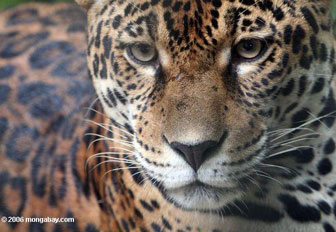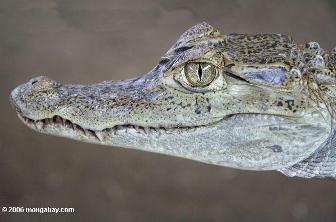A comprehensive look at the use of animals in Brazilian medicine
A comprehensive look at the use of animals in Brazilian medicine
Jeremy Hance, mongabay.com
December 10, 2007
|
|
For millennia animals have been used in medicine as remedies. While this practice has all but disappeared in western countries, many cultures still employ traditional medicine that includes animal-derived remedies. Probably the most famous of these are the Chinese, who for example use seahorses for a variety of ailments and rhinoceros horn as an aphrodisiac. Lesser known and studied, though just as varied and rich is Brazil’s long tradition of animal-remedies for all kinds of ailments. A recent study set out to document the wide-range of animals used in Brazilian traditional medicine and its possible consequences on animal populations, the environment, and Brazilian society.
 Jaguar in Colombia
Caiman in Colombia |
Brazil’s long and chaotic history has affected Brazilians’ use of animals in remedies. The colonization of Brazil by Europeans and the subsequent slave trade brought together three strains of medical thought: indigenous, European, and African. The indigenous and African systems of medicine were forced underground by the colonizers, but remained strong in local communities. Eventually, these two strands blended together. While herbal medicine predominates in these systems, animal-remedies play an important part.
To gain an understanding of contemporary animal-remedies in Brazil, scientists performing this landmark study visited local markets and interviewing merchants in various locations. To make the study truly comprehensive they studied previous reports and articles. The report identified 283 species being used for medicinal purposes. Nearly all of these are caught in the wild and 75 of them are on one or more endangered species list. Of the 283 species, fish are the most used (83 species), followed by mammals (54), reptiles (42), and birds and insects (both 33). The animals, or more often a part of them, are used to cure innumerable ailments from respiratory illness to poisonings to parasites. For example a whole American emerald tree boa mixed with alcohol is used to cure bites from stinging animals. A seahorse crushed into a tea is believed to alleviate everything from alcoholism to cancer. The Coraliomela brunnea, a type of beetle, is used to treat epilepsy. Fat from the Brazilian Tapir—rubbed on body or taken as tea—is employed to help asthma, rheumatism, tonsillitis, and other maladies. Many of these animals are additionally used as food sources, souvenirs, or in magical rituals. The rituals from Afro-Brazilian religions are often a part of healing a physical disease or curing a psychological, spiritual ailment.
Dr. Romulo R. M. Alves, one of the reports leading scientists, states that under Brazilian law the trade is illegal without wiggle-room for sustainable use or cultural rights. He cites article 29 of The Crimes Against the Environment to spell this out clearly: “To kill, to pursue, to hunt, to trap, to use specimens of the wild fauna, native or in migratory route, without the due permission, license or authorization of competent authority, or in disagreement with it constitute crime.8 Fines for an individual can reach up to 50,000 American dollars, an incredible sum considering most of the selling and capturing occurs amid Brazil’s poorer, rural areas. However, Dr. Alves states that the law is rarely employed since there is very little “patrolling or prevention” and “despite laws, use and trade of the species for medicinal purposes persists, and it is strongly associated by socioeconomic and cultural factors”. Due to these laws, the trade has become clandestine. For many this secret market is the most feasible (and sometime the cultural preferable) access to health care. Although Brazil’s health system is public, detailed and technological care are reserved for those who have the money to pay for it. The use of traditional remedies and rituals provide an economical way of healing for much of the populace, but that also does not mean that wealthy Brazilians don’t seek it out as well. Traditional medicine is a deep part of Brazilian heritage.
Since so many of the medicinal animals are endangered (or little known) it is a large concern that this trade may be adding additional pressure on already fragile populations. When interviewing merchants, Dr. Alves found that “most admit a reduction in the availability of some species, which can be a sign of the decline of their natural populations. However they don’t associate that decrease directly to the medicinal exploitation, instead they named other factors that it is related to the species’ decrease.” These factors were “deforestation, pollution, and destruction of the forests.” Dr. Alves sees these factors as valid and adds others: “the increase of the [Brazilian] population and the continuous technological progresses, worsened by the poverty and the lack of a better distribution of income.”
Dr. Alves wants to ensure that these animals are available in sustainable numbers for future generations. The report sees the need to strike a balance between the demand for traditional medicines and the animal populations that provide these medicines, including a four step process to insure the animals’ protection:
- Estimate the number of individuals in each species being used as medicines.
- Assess the conservation status and populations of these species.
- Develop a collaborative research program and monitoring of the trade.
- Finally, address any clinical or sanitary concerns.
This process, the report concludes, must be achieved with the help of conservationists that understand the cultural and religious beliefs that lead to animal-remedies.
Hopefully, with dedication, understanding, and new conservation measures the necessary balance can be found.
CITATION: Romulo R. N. Alves, Ierece L. Rosa, and Gindomar G. Santana (December 2007) The Role of Animal-derived Remedies as Complementary Medicine in Brazil. Bioscience.
 |
